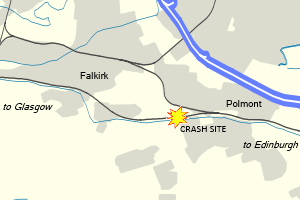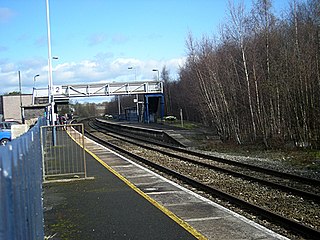External links
- Photograph from the National Railway Museum archives
- September 2013 Bugle article pertaining to the Welshampton rail crash
| Before 1850 |
|
|---|---|
| 1850s |
|
| 1860s |
|
| 1870s |
|
| 1880s |
|
| 1890s |
|
| Welshampton rail crash | |
|---|---|
| Details | |
| Date | 11 June 1897 |
| Location | Welshampton |
| Coordinates | 52°54′56″N2°49′55″W / 52.9155°N 2.8320°W Coordinates: 52°54′56″N2°49′55″W / 52.9155°N 2.8320°W |
| Country | England |
| Line | Oswestry, Ellesmere and Whitchurch Railway |
| Cause | Excessive speed/track condition |
| Statistics | |
| Trains | 1 |
| Deaths | 12 |
| List of UK rail accidents by year | |
The Welshampton rail crash was a fatal railway accident in the Welsh borders village of Welshampton on 11 June 1897. It resulted in the deaths of 12 people.
An excursion to Barmouth had been organised by the United Sunday Schools of Royton. A group of 320 passengers were on board a train of mixed Cambrian Railways (CR) and Lancashire & Yorkshire Railway (L&YR) stock of 15 carriages, pulled by two locomotives. Earlier in the day a CR guard had complained of the rough-riding of a small 4-wheeled L&YR brake van, which on the return journey was at the front of the train.
The train left Barmouth at 18:00. At about 22:20 one of the engines and 13 of the coaches left the rails of the CR's Oswestry, Ellesmere and Whitchurch Railway, 154 yards (141 m) east of Welshampton station. Nine passengers were killed in what was the first fatal accident on the line since it was built, two other passengers and a railway employee died later from injuries.
Although the initial investigation centred on the first carriage to leave the rails, an L&YR third-class brake coach, the enquiry concluded though that the speed of the train was too high considering the state of the track which had many sleepers in need of replacement, also too light a rail for high speed running. The CR disputed the findings and maintained that the L&Y vehicle was to blame.
A memorial on the front of the Town Hall in Royton, Greater Manchester names, those killed in the accident. A second memorial, installed by local people, at the side of the A495 Ellesmere to Whitchurch road, near to the site of the accident, shows the Cambrian Railways coat of arms. The railway line between Oswestry, Ellesmere and Whitchurch is now disused and, although some of the line is visible, the site of the accident itself has been ploughed out. Welshampton Station building still exists and has been converted into a house. This second memorial stone is located just in front of its fence by the roadside.

The Eschede derailment occurred on 3 June 1998, near the village of Eschede in the Celle district of Lower Saxony, Germany, when a high-speed train derailed and crashed into a road bridge. 101 people were killed and 88 were injured. It remains the worst rail disaster in the history of the Federal Republic of Germany and the worst high-speed-rail disaster worldwide. The cause was a single fatigue crack in one wheel that, when it failed, resulted in a part of the wheel becoming caught in a set of points, effectively changing the setting of the points whilst the train was passing over it. This led to the train's carriages going down two separate tracks, causing the train to derail and crash into the pillars of a concrete road bridge, which then collapsed and crushed two coaches. The remaining coaches and the rear power car crashed into the wreckage.

The Snowdon Mountain Railway is a narrow gauge rack and pinion mountain railway in Gwynedd, north-west Wales. It is a tourist railway that travels for 4.7 miles (7.6 km) from Llanberis to the summit of Snowdon, the highest peak in Wales.

The Lancashire and Yorkshire Railway (L&YR) was a major British railway company before the 1923 Grouping. It was incorporated in 1847 from an amalgamation of several existing railways. It was the third-largest railway system based in northern England.
The Cambrian Railways owned 230 miles (370 km) of track over a large area of mid Wales. The system was an amalgamation of a number of railways that were incorporated in 1864, 1865 and 1904. The Cambrian connected with two of the larger railways to give connections to the northwest of England via the London and North Western Railway, and with the Great Western Railway for connections between London and Wales. The Cambrian Railways amalgamated with the Great Western Railway on 1 January 1922 as a result of the Railways Act 1921. The name is continued today in the route known as the Cambrian Line.

The English county of Shropshire has a fairly large railway network, with 19 National Rail stations on various national lines, as well as a small number of heritage and freight lines, including the famous heritage Severn Valley Railway running along its eastern border with Worcestershire.

The Cambrian Line is a railway that runs from Shrewsbury to Aberystwyth and Pwllheli, both on the west coast of Wales. The line from Dovey Junction to Pwllheli is sometimes called the Cambrian Coast Line.

The Abermule train collision was a head-on collision which occurred at Abermule, Montgomeryshire, Wales on 26 January 1921, killing 17 people. The crash arose from misunderstandings between staff which effectively over-rode the safe operation of the Electric Train Tablet system protecting the single line. A train departed carrying the wrong tablet for the section it was entering and collided with a train coming the other way.
The Charfield railway disaster was a fatal train crash which occurred on 13 October 1928 in the village of Charfield in the English county of Gloucestershire. The Leeds to Bristol London, Midland and Scottish Railway (LMS) night mail train failed to stop at the signals protecting the down refuge siding at Charfield railway station. The weather was misty, but there was not a sufficiently thick fog for the signalman at Charfield to employ fog signalmen. A freight train was in the process of being shunted from the down main line to the siding, and another train of empty goods wagons was passing through the station from the Bristol (up) direction.

Newtown railway station is a railway station serving Newtown in Powys, Wales.

Welshpool railway station on the Cambrian Line in Powys, mid-Wales, serves the town of Welshpool.

Over the latter years of the 19th and early years of the 20th centuries, Penistone in Yorkshire gained a name as an accident black-spot on Britain's railway network; indeed, it could be said to hold the title of the worst accident black-spot in the country. The main line through the town was the Woodhead route of the Manchester, Sheffield and Lincolnshire Railway between Sheffield Victoria and Manchester, London Road. The line was heavily graded with a summit some 400 yards inside the eastern portal of the Woodhead tunnel.

The Polmont rail accident, also known as the Polmont rail disaster, occurred on 30 July 1984 to the west of Polmont, near Falkirk, in Scotland. A westbound push-pull express train travelling from Edinburgh to Glasgow struck a cow, which had gained access to the track through a damaged fence from a field near Polmont railway station. The collision caused all six carriages and the locomotive of the train to derail, killing 13 people and injuring 61 others. The accident led to a debate about the safety of push-pull trains on British Rail.

Whitchurch (Shropshire) railway station serves the town of Whitchurch in Shropshire, England. The station is 18¾ miles (30 km) north of Shrewsbury on the Welsh Marches Line. The station is maintained and served by Transport for Wales.
Rednal rail crash was a rail accident that occurred near Rednal station in Shropshire.
The Crewe and Shrewsbury Railway is a railway which was previously owned by the London and North Western Railway (LNWR) company, built to connect Crewe with the Shrewsbury and Hereford Railway which was jointly owned with GWR.
The Marden rail crash occurred on 4 January 1969 near Marden, Kent, United Kingdom, when a passenger train ran into the rear of a parcels train, having passed two signals at danger. Four people were killed and 11 were injured. One person was awarded the British Empire Medal for his part in the aftermath of the collision.

Oswestry railway station is a Grade II listed heritage railway station in Oswestry, Shropshire, England. It was closed when passenger services were withdrawn in 1966. The station building today is used as commercial premises.
The Oswestry, Ellesmere and Whitchurch Railway was a railway company that constructed a line from Whitchurch via Ellesmere to Oswestry. Most of the line was in Shropshire but part entered Flintshire, now Wrexham County Borough. It was seen as a link from the local railways around Newtown to the London and North Western Railway, breaking the local monopoly of the Great Western Railway. It opened as a single line in 1863 and 1864. Throughout the construction period it was short of money, and was paid for by the contractor, who took shares. Sporadically through its life it became a useful part of a through route for mineral trains, but it never developed greatly.
The Wrexham and Ellesmere Railway was a railway line that ran from Wrexham in North Wales, to Ellesmere in Shropshire, England. The line opened in 1895 and closed in 1962, except for a residual goods service which itself closed in 1981.
Whittington High Level railway station is one of two former railway stations in the village of Whittington, Shropshire, England.